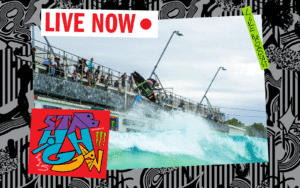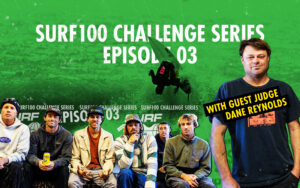He Has One Leg, Has Been Surfing For One Year, And Gets More Barreled Than You
Employing a technique made famous by Josh Kerr.
The first thing you’ll notice about Dariel Meléndez Dávila is his charming, boyish smile.
The next thing that you’ll notice is he’s missing a leg—like, a whole leg. Which seems like a pretty difficult thing to deal with, you know, just generally.
Then you watch Dariel surf, and you start to reconsider the term “disability”.
Employing a technique first seen in the early-2000s Rusty film, Changes (watch the relevant section above), Dariel uses his left arm as a proxy for his front leg, applying pressure to the board’s sweet spot, thus allowing it to plane on the wave face.
With his back foot planted firmly on the traction pad, Dariel is able to maneuver his board with incredible dexterity, turning swiftly in the pocket and often hibernating in the tube. (He loves the tube.)
All of which would be incredible in its own right, but these facts take on considerably more weight when you learn Dariel’s backstory—most notably that he’s only been surfing for one year.
Below, we chat with Dariel about all the relevant tidbits and more.
Stab: Hey Dariel, how old are you?
Dariel: Im 19, I’ll be turning 20 in August.
And where are you from in Costa Rica?
I live in Puerto Viejo, a small town on the Caribbean coast.
Is that where you learned how to surf?
Yup, in Playa Negra. What we call “El Lanchon”.
Negra is a pretty heavy beach break to learn at, no?
It has its points. It’s bigger near the rivermouth—that’s definitely where you get the tubes from. But it’s a little softer where I learned.
How old were you when you started surfing?
18.
…So you’ve only been surfing for one or two years?!
Yeah, around one year.

Can’t fight the feeling. Photo: @yilbart
Good god, man! That’s incredible. I know some folks who have been surfing for a decade (with both legs, mind you) who aren’t even close to your level. Sorry for being intrusive, but were you born without a leg, or did you lose it later in life?
I had an accident when I was 11 where I lost it. I don’t really like talking about that too much, but the accident was with a train.
I’m sorry to hear that. Let’s focus on the present. You’ve been without the leg for around 8 years… what made you want to start surfing recently?
Well, living in Puerto Viejo I would see people walking around with boards, and see them surfing when I was on the beach. And it always kind of enticed me, but I had never truly dared to try it out. Until I was talking to a friend, who had just come back from an Adaptive Surfing camp—a special one for people with disabilities. That’s when I found out that there is an entire network, an entire family, of surfers with disabilities. And that was what did it for me, that was essentially what motivated me to start.
Did someone have to explain how to use your hand on the board as a proxy for your front leg, or did you figure that out on your own?
It was a whole process of adapting, a full adventure. Because of course there was no instructions or manual on how to teach someone with my specific disability how to surf. So it was a bunch of my ideas, starting to test out whether I should hold onto the rails, where I should put my hand, my leg. Whether I should get up at all or if I should just stay sitting or crouched low, and little by little I started trying stuff and listening to people giving me tips telling me like, “Maybe try putting some more weight on the back or on the front, you’ll gain more speed.” I sort of complied all that information until I got to this particular stance or style or whatever.
What if I told you that Josh Kerr and the early-2000s Rusty crew practiced your technique back in the day (see top of screen for reference, then check Dariel’s version below)?
Oh yeah, I think I saw that video! It’s pretty cool, I can learn a lot from those guys. I wish I’d seen that before I started, would have saved me a lot of time [laughs].
How many months passed before you could actually stand up and get down the line?
My first real wave was probably like three months after I started.
That’s unbelievable! I also hear you’ve been surfing Salsa Brava [the heaviest wave in the region, a true reef slab]. Is that true?
Yeah, I’m working my way into it. Paddling out and learning more and more about the wave because, you know, it’s definitely a very heavy wave. So I go out on smaller-medium days, working my way up. Hopefully we can get a little tube on this swell coming up.
And where have you caught your best tube so far?
I think the best one so far has been in Cocles [a local beach break].
What’ s your favorite wave?
Cocles, and then [redacted], which is a secret spot [laughs].
What other waves are you looking forward to surfing in Costa Rica?
I’ve really been looking forward to surfing the rights at Witches’ Rock—that wave, I don’t know what it is about it, but it has me in love. The rock, the whole place, it really exudes some magic. I still haven’t been there but I’ve seen how, when it gets good, it fires.
And what about outside of Costa Rica? If you had to pick any wave in the world to surf, which would it be?
That’s a good one, let me think… Probably the perfect rights of the Mentawais. Like Lance’s Right.
Do you not like going backside?
No, yeah, I do, I do! I’m regular, I like frontside better, but I also ride backside. As far as lefts go, I’d love to surf Pipeline. Of course that would take a lot more training… but we’ll see how my progression goes.
Yeah, that’s a big leap, to say the least. But not out of the question, considering how good you’ve gotten in just one year. Have you ever competed?
Yes, I am currently on the Costa Rican national circuit—because we now have a category for adaptive surfing. And I am also on the national adaptive surf team.
You must be winning the circuit.
[Laughs] I’m actually 3rd in the rankings right now.
Ok but in one year, that’s amazing! Especially having started later in life—for most people, it’s really hard to gain the muscle memory necessary to become a proficient surfer if they don’t start when they’re young.
You know, I actually think starting later might have been helpful to me. Because I learned after my accident, so I didn’t have to un-learn or re-learn the way to ride if I had known how to surf before the accident. I didn’t get that sort of shock that someone who practiced it before might get, I didn’t have anything to compare it to, and didn’t have to re-adapt, I just had to learn how to surf from scratch basically.
That’s a great way to think about it. How often do you surf?
I try to do it every day. It’s my favorite thing. Apart from my studies, that’s the only other thing I’m focusing on right now.
And what do you study?
Right now I’m getting a Bachelor’s degree in natural sciences.
Do you work, too?
Well, I did, but now with covid everything has sort of come to a halt.
How do you get around on land?
Crutches for the most part.
And what type of board do you ride?
[Laughs] Well I like high-performance shortboards. Right now I ride a 5’9 shaped by a local guy—I’m like 1.70m.
So what’s your end goal with surfing?
My biggest goal is to make it to the ISA and of course to qualify for the Special Olympics. In Costa Rica, we are ranked number 18 in our circuit, so we’ll need to improve that if we want to qualify. But I think we can do it.














Comments
Comments are a Stab Premium feature. Gotta join to talk shop.
Already a member? Sign In
Want to join? Sign Up